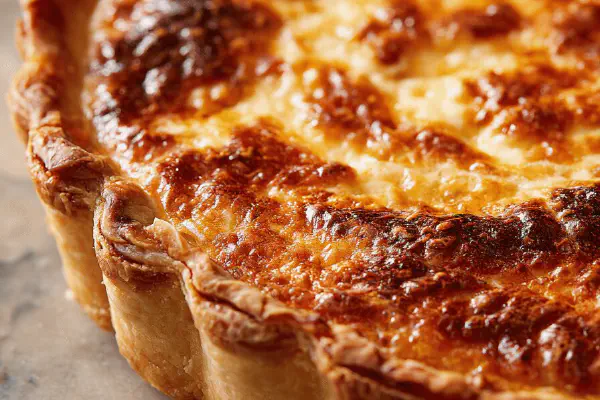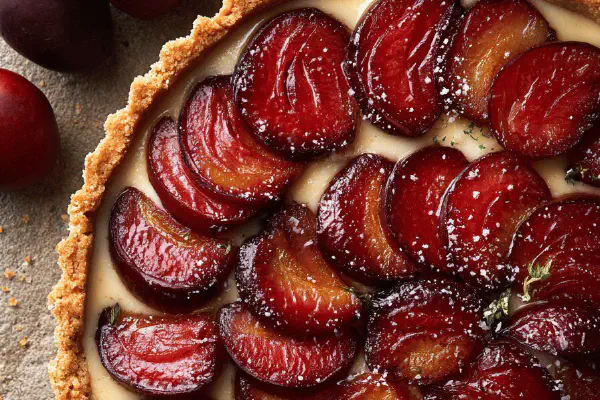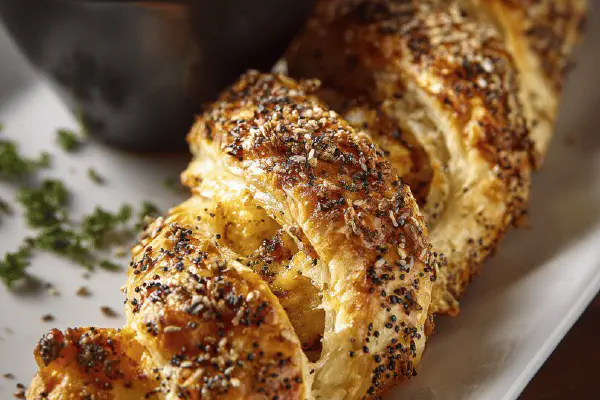Savory Brisée Dough

By Emma
Certified Culinary Professional
Ingredients
- 170 g (1 ¼ cups) cake flour *sub for all-purpose*
- 2.5 ml (½ tsp) baking soda *instead of baking powder*
- 2.5 ml (½ tsp) fine sea salt
- 85 g (6 tbsp) unsalted cold butter, diced
- 30 g (2 tbsp) cold rendered pork fat or lard *partial butter replacement*
- 45 ml (3 tbsp) cold buttermilk *instead of milk*
- 1 large egg
About the ingredients
Method
- Pulse flour, baking soda, and salt in food processor few seconds. Crumbs like sand. No overmixing — no glue.
- Add butter and pork fat cubes. Pulse short bursts until pea-size lumps. Watch texture; if too big, a few more pulses. Too fine? You lost the flake.
- Beat egg with buttermilk, toss gently in. Pulse just till dough clumps. Sticky enough to hold, dry enough to handle. Add drop more buttermilk if needed.
- Dump dough on floured board. Quick hands—split into 2 thick discs. Pat flat, wrap tight with plastic.
- Chill minimum 35 minutes. Dough firms, flavors marry. Rushing results in tough crust or tears when rolling.
- Roll out chilled discs between floured parchment for 23 to 25 cm diameters. Thin but not paper. Edges slightly thicker—resist thinning to prevent sogginess.
- Dock base lightly with fork or small holes. Avoid overworking dough here. Perforations stop bubbles, keep base even.
- Blind bake if recipe calls for wet fillings—line with foil, fill beans or weights, bake at 190C till edges get pale golden and dough looks matte, about 10-12 minutes.
- Cool slightly before filling. If filling chilled, dough temp matters—too warm makes slipshod edges; too cold cracking. Balance is experience.
- Notes: Cake flour reduces gluten, helps flakiness but less structure—you might add a touch more flour or chill dough longer if it feels slack. Pork fat adds that heritage savor, worth the hunt in freezer section or butcher shop. If no buttermilk, sour milk (milk + acid) is acceptable, but watch for curdling.
- Common mistakes: Overworking dough destroys the flaky mystery. Too warm, dough turns sticky nightmare. Undercold, cracks open like old paint.
- Efficiency: Use food processor but pause often. Dough tells you when ready—listen to texture, not clock.
Cooking tips
Chef's notes
- 💡 Pulse flour, soda, salt till crumbly. No grind mush. Fat bits gotta stay chunky. Overprocessing kills flake fast. Watch dough texture closely; pea-sized bits hold layers. Use cold fats — butter, pork fat firm — keep processor cold too. Add buttermilk gradually, sticky but firm dough is right spot. If it’s dry, small drops not floods. This dough's forgiving but tweak carefully.
- 💡 Chill dough minimum 35 minutes in tight wrap. Do not rush. Cold stiff dough means less springback, easier rolling. Warmer dough sticks, tears, cracks like brittle leaves. Two discs help with handling, no giant sheet wrestling. Wrap well, plastic that doesn’t dry out — shiny wrap or multiple folds keep moisture locked. Rest tones gluten; result is tender not tough crust.
- 💡 Roll between parchment, skip extra flour; dry flour toughens crust, kills tenderness. Roll thin but not paper—edges thicker but avoid dough pile. Dock with fork holes or light pricks to stop bubbles when blind baking wet fillings. Bubbles scorch crust, crack moldy base. Blind bake at 190 C; dough looks matte, edges faintly gold, 10-12 minutes. See crust visuals not time only.
- 💡 Substitute cake flour with all-purpose flour if needed but add chill time. If no pork fat, extra cold butter or coconut oil works—expect different flake, aroma changed. Baking soda requires acid; use buttermilk or sour milk substitute. Watch curdling with sour milk; mild acid reacts but too much acid ruins texture. Salt precise — fine fresh sea salt avoids gritty patches. Coarse salt sneaks through unevenly.
- 💡 Handle dough quickly, cold hands best but not frozen frost. Warm palms melt fats early, dough loses structure. Pulse, watch texture, toss, pulse again—not continuous blending. Dough sound changes; faint thuds slow down, fat firms up again. Dough cracks slightly at edges when rolled, signals readiness, no crumbly disintegration allowed. Crack patched with dusted flour, quick hands save fragile work.
Common questions
Why cake flour instead all-purpose?
Lower protein less gluten, crumb tender, not tough. Structure lighter but handle with chill or dough slackens. If AP used, prolong chill time or add bit flour to absorb moisture. Cake flour means softer but careful with overmixing, else gluey.
Can I use regular milk instead buttermilk?
Not quite. Buttermilk acid reacts with baking soda, adds tang, subtle lift. Regular milk neutral, no reaction, dough denser. Alternate sour milk works—add lemon or vinegar to milk, wait slight curd. Avoid store-bought vanilla yogurts; too thick changes hydration.
Dough cracks or tears rolling out, what then?
Dough too cold or dry. Let rest few minutes room temperature but not melted. Patch cracks with flour dust and bit of dough pressed. Overkneading breaks fat chunks, losing flakiness. Temperature key: cold but not frozen, firm but pliable.
How store leftover dough?
Wrap tight in plastic, refrigerate max 24 hours or freeze up to month. Thaw in fridge overnight, re-chill before rolling. Freezing stretches gluten, slight differences in texture appear, dough handles well with chill. If fridge-stored dough feels slack, fold in little flour, roll quickly.



